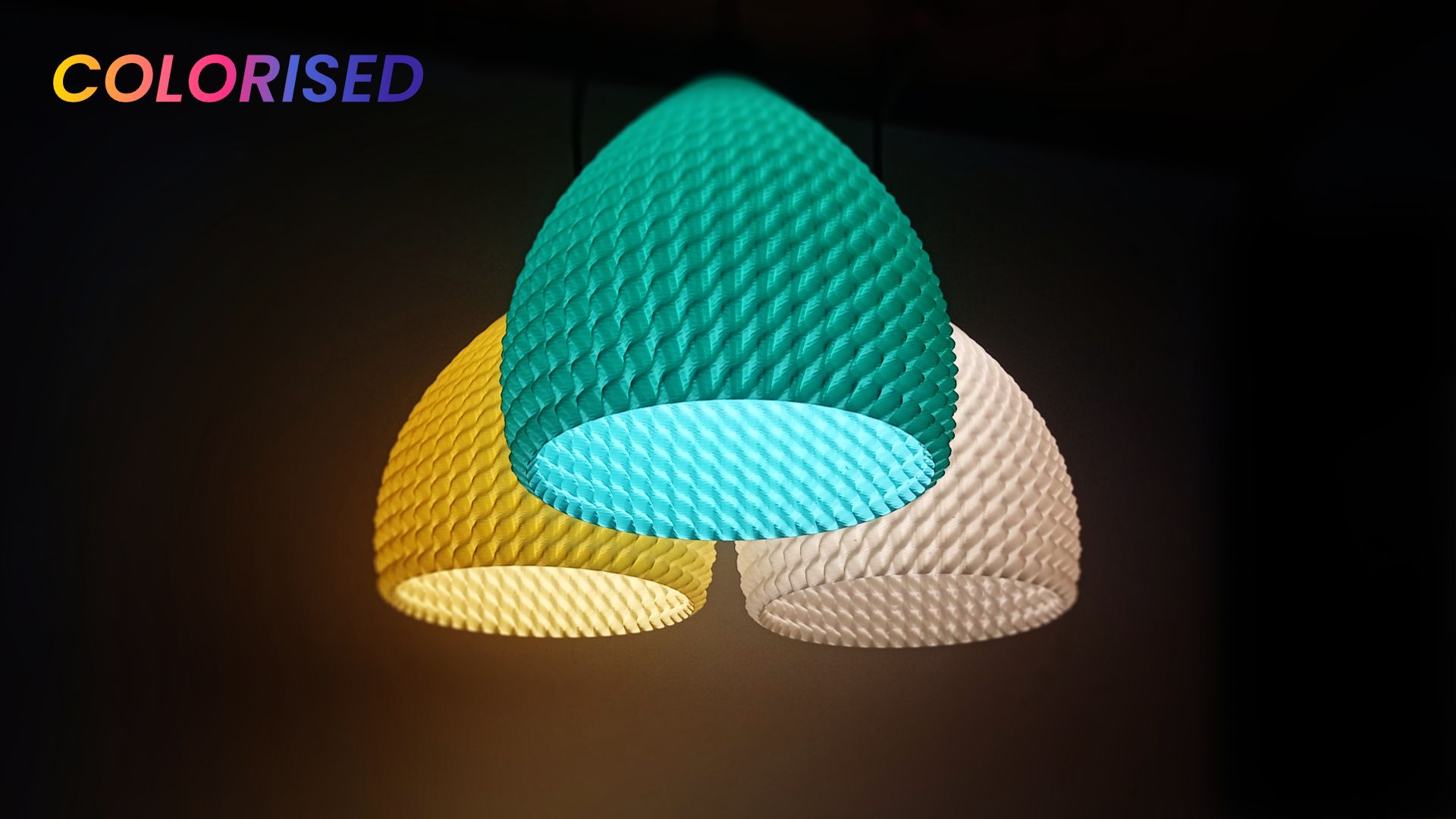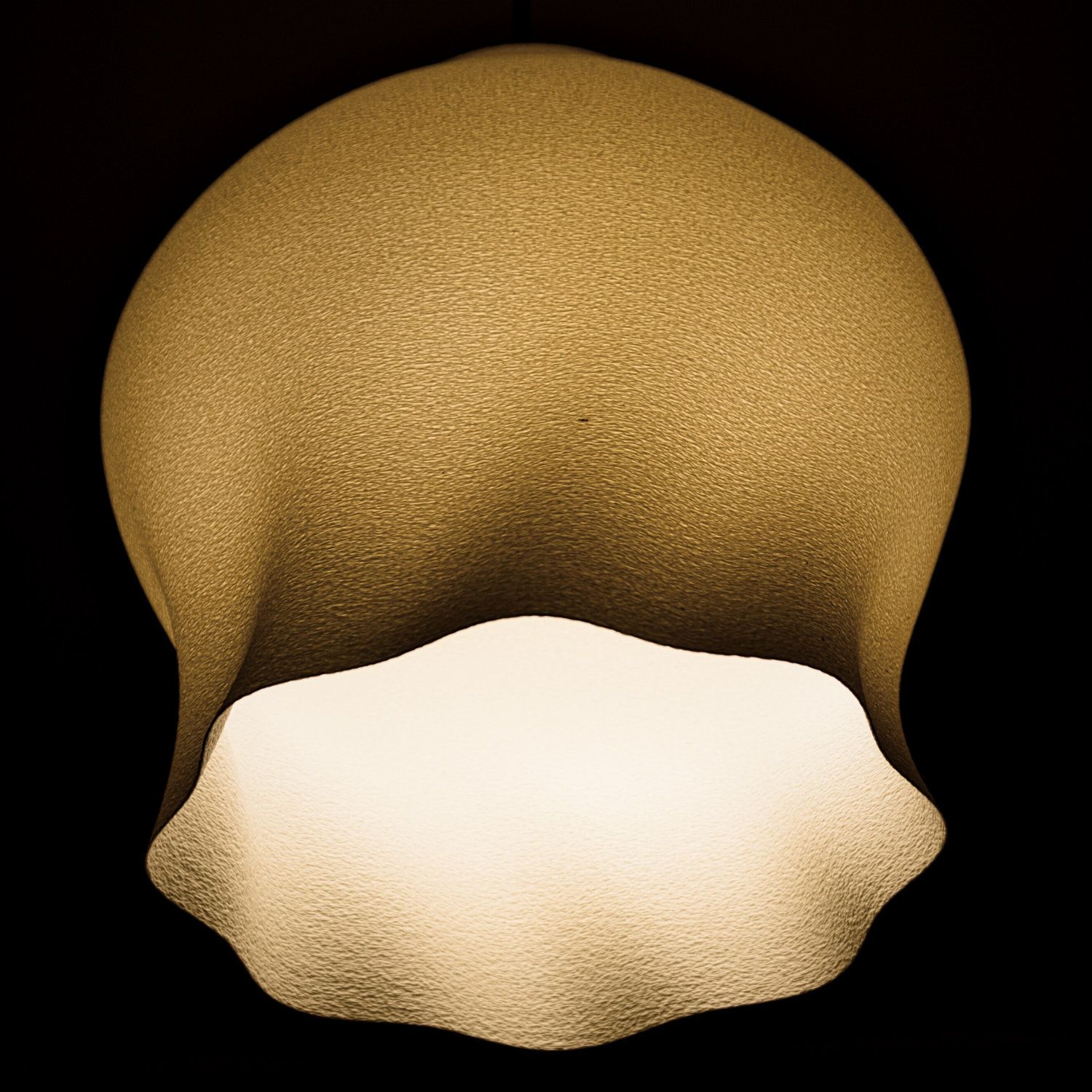Lighting that meets the essence of nature: this is the reality brought to life by ECO Lamps, which introduces a fresh perspective to sustainable lighting design using potato starch. These lamps are a product of Colorised, a company dedicated to innovative interior solutions. Collaborating with Poland’s largest chemical brand, Grupa Azoty, Colorised has ventured into the realm of sustainable lighting, focusing on using natural, compostable materials and additive manufacturing. The ECO Lamp embodies artistic design and environmental responsibility, showcasing how everyday objects can be transformed into eco-conscious art pieces.
In this collaboration, Colorised brings its expertise in interior design, while Grupa Azoty provides bioplastics know-how, and Greenfill3D has its expertise in biodegradable and compostable bioplastics for additive manufacturing. Together, they have developed a lamp made from compostable materials like potato starch, a significant step away from traditional, less eco-friendly materials. The result is a lamp that not only lights up spaces but does so in a way that minimizes environmental impact. Moreover, the ECO Lamps are available in three eco-friendly colors—original pearl-white, yellow vanilla, and greeny mint—using food-grade dyes.
However, what’s unique about these lamps is their composition. The materials – potato starch, wheat bran, and cornstarch – are not typically associated with lighting fixtures. This unconventional choice highlights Colorised’s commitment to pushing the boundaries of sustainable design. These materials are environmentally friendly, fully biodegradable, and compostable, aligning perfectly with the global push towards a circular economy.
Made in the EU
Made entirely in Poland, the ECO Lamps showcase the best of European craftsmanship. Every part of these lamps, from the materials to the smallest components, is sourced from within the European Union (EU). This local sourcing is critical to the lamps’ sustainability narrative, reducing the carbon footprint associated with the long-distance transportation of materials.
One of the most attractive aspects of the ECO Lamps is the brand’s customization, ensuring each lamp can be tailored to individual tastes and requirements. Whether it’s the lamp’s shape, color, or unique features like antibacterial properties, each can reflect the customer’s style and environmental values.
Furthermore, the production process of ECO Lamps harnesses the potential of 3D printing to bring their unique designs to life. Starting with meticulously created 3D models, each optimized for efficient production, Colorised, Grupa Azoty, and Greenfill3D work closely to refine and finalize the designs, ensuring they meet the highest quality and sustainability standards. Once a design is approved, the production phase commences. Once the production process is complete, the finished lamps are photographed and shared with customers, followed by a streamlined payment and delivery process.
Biodegradability at Its Best
According to Colorised and Greenfill3D CEO Pawel Slusarczyk, in early April 2023, Greenfill3D introduced an ecological concept for protective frames for light switches and sockets under the Colorised collection, featuring a vast array of shapes, colors, and UV technology prints. This venture led them to the lighting industry, where market research revealed a prevalence of 3D printed lamps. However, these lamps, often made from Polylactic acid (PLA), lacked innovation and eco-friendliness, explains Slusarczyk in a LinkedIn post from December 2023. Despite being popular for its biodegradability, PLA requires industrial conditions to degrade, leading to its frequent end in landfills rather than composting facilities. Acknowledging this, the Colorised team initially experimented with PLA for the ECO Lamps but soon realized its limitations. The breakthrough came with potato starch.
“The first trials made of this material in its natural, pearl-white color turned out to be spectacular – both before and after lighting. This material has a characteristic, silky surface that naturally looks like glass. When turned on, an ECO Lamp made from potato starch at first glance does not differ from a glass lamp. But the biggest advantage of potato starch is its compostability – not biodegradability. Yes, these are two completely different processes. Potato starch decomposes in home composters or in the soil after burial. Depending on the size of the element and the thickness of the walls, decomposition can occur within weeks or months – but it will happen sooner or later (this doesn’t work with PLA),” remarked Slusarczyk.
Working with thermoplastic starch is not significantly different from 3D printing with PLA, went the executive. However, one of the challenges is its “relatively high hygroscopicity” (directly related to its compostable properties). The material does not require constant drying like, for example, polyamide, but definitely, you cannot leave open filaments for a longer time in an office or production space, as they will start to degrade relatively quickly, he says.
“Too moist material is characterized by typical ‘popping’ during 3D printing and leaves artifacts on the surface of prints – which in the case of ECO Lamps disqualifies it (once lit, any imperfections are immediately visible – prints must always be perfect),” indicates Slusarczyk. “The solution to this problem turned out to be quite trivial, and we call it ‘open-and-use.’ When starting the production of ECO Lamps of a given color, we precisely calculate the work times and material consumption for individual models and produce the entire batch within 24-30 hours.”
Challenging the Norms
In eco-friendly lighting, Europe boasts an impressive array of innovators and designers committed to sustainability. For instance, Philips Lighting from the Netherlands leads the way with its energy-efficient LED solutions, setting a high standard in the industry. Italy’s Plumen and the UK’s Tala stand out for their unique blend of energy-saving LED technology and award-winning designs, highlighting aesthetics and eco-consciousness. At the same time, Swedish giant Ikea has made a turn towards sustainability by committing to selling exclusively LED lighting.
Danish brands like Ferm Living and Muuto bring a touch of minimalism to the eco-friendly lighting scene, using recycled materials and sustainable practices. Italian design expertise shines through Artemide’s environmentally conscious products, which focus on recyclability and energy efficiency. In Germany, Ingo Maurer’s artistic approach to lighting includes using energy-saving technologies. Similarly, Denmark’s Gubi merges luxury with sustainability, offering durable materials mixed with energy-efficient lighting. These brands collectively represent the diverse and innovative landscape of eco-friendly lighting options in Europe, each contributing to a greener future in their own unique way.
Exclusive, Organic, and Handmade
In a move that sets them apart from the other eco-friendly lighting options, Colorised has chosen potato starch over more commonly used materials like PLA. While PLA is biodegradable, its process is not as straightforward, often requiring industrial conditions. Instead, potato starch can be composted at home, breaking down naturally and reducing waste.
More than just light sources, the ECO Lamps from Colorised represent a new way of thinking about product design, where aesthetics, functionality, and environmental responsibility are given the same relevance. They demonstrate that innovation in sustainability can be simple and practical yet significantly impact how we view and use everyday products. Maybe we can think of these lamps as more than just lighting furniture but tools illuminating a path towards a more sustainable and eco-conscious way of living.
Subscribe to Our Email Newsletter
Stay up-to-date on all the latest news from the 3D printing industry and receive information and offers from third party vendors.
Print Services
Upload your 3D Models and get them printed quickly and efficiently.
You May Also Like
Consolidation in AM: How 2025 Is Shaping the Industry’s New Normal
The first half of 2025 has been marked by a clear shift in the additive manufacturing (AM) industry. Companies are no longer just focused on developing new tech by themselves....
Etsy Design Rule Change Reduces Selection of 3D Printed Goods
Online marketplace Etsy has implemented a rule change requiring all 3D printed goods on the site to be original designs. The update to the site’s Creativity Standards states, ¨Items produced using...
U.S. Congress Calls Out 3D Printing in Proposal for Commercial Reserve Manufacturing Network
Last week, the U.S. House of Representatives’ Appropriations Committee moved the FY 2026 defense bill forward to the House floor. Included in the legislation is a $131 million proposal for...
Transforming From Tourist to Native: Duro CEO Michael Corr Explains Why the Company Rebuilt its PLM Software on AI
In these early innings of the AI boom, many market analysts have expressed concern that AI spend has gotten too far ahead of the technology’s proven ability to deliver significant...



































